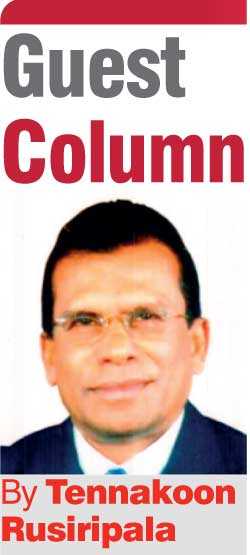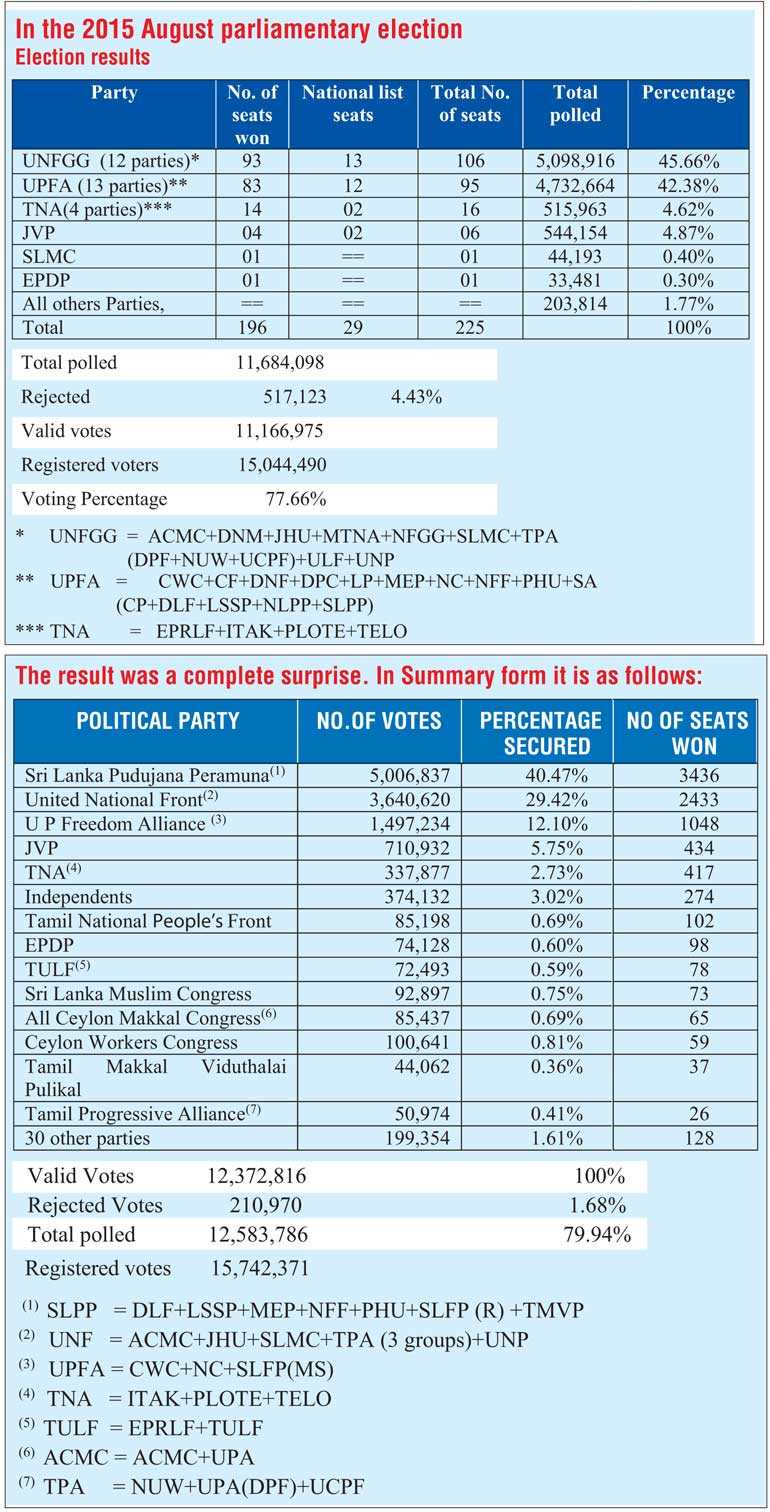Friday Apr 04, 2025
Friday Apr 04, 2025
Thursday, 31 October 2019 00:52 - - {{hitsCtrl.values.hits}}
 The Presidential Elections are around the corner. The contestants are lining up for spiritual blessings. Places of worship and other holy sites are being generously patronised. However, recent events and developments do speak loudly of the possibilities and the available statistics in the political sphere are more relevant than empty grandstanding.
The Presidential Elections are around the corner. The contestants are lining up for spiritual blessings. Places of worship and other holy sites are being generously patronised. However, recent events and developments do speak loudly of the possibilities and the available statistics in the political sphere are more relevant than empty grandstanding.
In this context, let us examine some of the relevant statistical information available.
At the last Presidential Election, the voting was as follows:
Sirisena claimed 12 districts while 10 districts were won by Mahinda Rajapaksa, with an Average Voting Percentage of 81.52%.
The lowest polling percentages were recorded from the Vanni with 72.57%, Trincomalee at 76.76%, Puttalam at 73.81%, Jaffna at 66.28% and Batticaloa at 70.97%.
The votes received by the winning candidate included those for the United National Party (UNP), a section of the Sri Lanka Freedom Party (SLFP), Tamil National Alliance (TNA), Sri Lanka Muslim Congress (SLMC) and some other parties. Of the parties other than the UNP, the largest vote contribution came from the SLFP.
The TNA, comprising four parties, secured a total of 515,963 votes, annexing 4.62% of the total votes polled.
The JVP polled 543,944 votes, securing 4.87% of the total votes.
During the Presidential Election both these factors contributed to the total polled by the NDF headed by Sirisena. It is also reported that there is a new development in the North and East where the TNA was dominating, with speculation about a protest vote against it because it had failed to bring about any development in these areas. Many believe that the TNA’s sole role has been to enable the survival of the UNP Government and it has neglected the welfare and problems of the ordinary people who supported it.
Several small political groupings have openly denounced the list of demands put forward by the TNA to both major political parties seeking their recognition and acceptance if the TNA is to extend their support to them during the Presidential Election. These groups have pronounced that the TNA is bringing forward these illusory demands deceitfully to obtain the support of Tamil voters and to mislead them.
This new school of thought points out that the TNA has completely failed to address the issues confronting average Tamil citizens.
There are hundreds of thousands of Tamils living in extreme poverty in the North and East. The TNA has failed to grant or obtain from the Government, any redress for these poverty-stricken citizens and they have been left in their destitute and impoverished state without any remedial action being taken.
The self-determination claim made by them is not what the people of North and East require. They only want equality, impartiality, fairness and infrastructure facilitation for them to be economically viable and self-sufficient. They want to live in peace and harmony in any part of the country without any discrimination. They yearn for communal harmony with the majority Sinhalese. The young and the educated Tamil youth, grouped together with these broad objectives, have declared in no uncertain terms that they are for one country and one rule with equal opportunities extended to all. They are very seriously concerned about the natural resources and the unexploited resource base available in the North and East and they demand the full utilisation of this potential for the benefit of the country.

These educated youth have contacts with their colleagues living all over the world, identified as the Tamil Diaspora, and are confident that their cause will be supported by the Diaspora in many ways, such as technological support, know-how, investment, etc.
They are ready to register a political party initially confined to Tamil-speaking areas with the broad objective of representing them and obtaining solutions to their problems. Already they have started their campaign, educating the voters about the farcical and ludicrous operations of the associated political parties under the TNA, strongly denouncing the divisive communal policies they pursue ostensibly to hoodwink the Tamil voters to achieve their ulterior motive of sharing power with the Government by supporting their survival and enjoying benefits at the expense of the rights of the masses whom they represent. They state that the TNA is committing a crime by forgetting the wellbeing of the masses while continuing their cordial relations with the Government.
First, the TNA wanted an assurance from the main parties about their separatist demands but they have now declared that the TNA is supporting Sajith Premadasa for the presidency. This leaves us with the unanswered question as to whether the TNA has obtained the required assurance from the UNP. Another secret compact?
The TNA factor is of significant importance to Premadasa’s vote bank. Therefore, any development such as the emanation in the North and East described above will have a serious negative impact on his result.
Grand finale
In 2018 February, Local Government Elections were held. It was the largest election in the history of Sri Lanka where elections were held on the same day for 340 local authorities including Municipal Councils, Urban Councils and Pradeshiya Sabhas (Divisional Councils).
There were some significant factors associated with this election, namely:
The SLPP has won 16 districts while the United National Front secured victory only in the Ampara, Badulla, Mannar and Nuwara Eliya districts while the Tamil National Alliance won in the Batticaloa, Jaffna, Kilinochchi, Mullaitivu and Vavuniya districts.
The JVP, which is contesting the Presidential Election, has publicly declared that their voters will not cast a second preference, hence it will be a sizable swing away from the UNP front.
The Government, which is virtually reduced to the UNP-backed parties, is facing serious disadvantages due to their poor governance accounting for several factors, such as the shockingly alarming security situation of the country.
It appears to be a hard business trip for any and all presidential candidates who have emerged from nowhere to get anywhere close to the finish in this race. But for someone like the SLPP’s Gotabaya Rajapaksa, who had been toiling for some time now, openly interacting with the masses, elite and intellectuals of the country, arming and fortifying himself with sound policies while plodding his way up towards his candidature, the journey may not be so difficult with the support his party has already built. This may appear incredible to those toying with speculation, but it is a fact as the statistics will show.

Discover Kapruka, the leading online shopping platform in Sri Lanka, where you can conveniently send Gifts and Flowers to your loved ones for any event including Valentine ’s Day. Explore a wide range of popular Shopping Categories on Kapruka, including Toys, Groceries, Electronics, Birthday Cakes, Fruits, Chocolates, Flower Bouquets, Clothing, Watches, Lingerie, Gift Sets and Jewellery. Also if you’re interested in selling with Kapruka, Partner Central by Kapruka is the best solution to start with. Moreover, through Kapruka Global Shop, you can also enjoy the convenience of purchasing products from renowned platforms like Amazon and eBay and have them delivered to Sri Lanka.
Discover Kapruka, the leading online shopping platform in Sri Lanka, where you can conveniently send Gifts and Flowers to your loved ones for any event including Valentine ’s Day. Explore a wide range of popular Shopping Categories on Kapruka, including Toys, Groceries, Electronics, Birthday Cakes, Fruits, Chocolates, Flower Bouquets, Clothing, Watches, Lingerie, Gift Sets and Jewellery. Also if you’re interested in selling with Kapruka, Partner Central by Kapruka is the best solution to start with. Moreover, through Kapruka Global Shop, you can also enjoy the convenience of purchasing products from renowned platforms like Amazon and eBay and have them delivered to Sri Lanka.